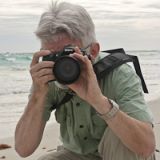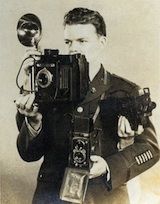- Forum
- General Discussion | Introductions | Off Topic Forum
- Photography General Discussion
- Determining flash settings in manual mode?
Determining flash settings in manual mode?
-
 Topic Author
Topic Author
- Kenya See
- The Lounger
-
- Nikon Z6 and D7000
- Followers: 235
- Posts: 1069
-
Points:
10124
Post #152511
-

- Studio Queen
- Moderator
-
- Canon 50D
- Followers: 182
- Posts: 491
-
Points:
26748
Post #152514
-
 Topic Author
Topic Author
- Kenya See
- The Lounger
-
- Nikon Z6 and D7000
- Followers: 235
- Posts: 1069
-
Points:
10124
-

- cod
- Snapobsessed
- Nikon D300S
- Followers: 71
- Posts: 484
-
Points:
1165
Post #152574
-

- Henry Peach
- Apprentice
-
- I currently use a 5DII or Sony Nex-3 most of the time.
- Followers: 50
- Posts: 2925
-
Points:
16
Post #152646
You can find the guide number for your flash in the instructions or on the manufacturer's website. It is usually listed for ISO 100 in meters & feet.
When calculating stops remember that doubling or halving ISO is 1 stop, but doubling or halving distance or f/# is 2 stops. Flash power may be adjustable in 1, 1/2, or 1/3rd stop increments.
Example: If your GN is 110, and the flash is 10' from the subject, then f/11 should be a good place to start.
Do some personal testing. You may want to modify the manufacturer's GN a bit to suit your real world shooting experiences or to adjust for flash mods you typically use.
I used to tape a chart listing common distances and f/stops I used with the appropriate power setting on the back of my flash until I got it memorized. I've been buying the same power flashes for so long that I haven't had to do that in a while.
-

- MLKstudios
- Banned
-
- D800 ;-)
- Followers: 72
- Posts: 4480
-
Points:
2
Post #152676
Most flashes will have an AUTO mode (pre-TTL) that will adjust the flash output for you (if the sensor can see the subject).
If not, you will have to experiment to find the right settings (or buy a flash meter).
The key to using ONE LIGHT is to understand that you are actually using TWO. Balancing the flash with the ambient is what makes a good flash exposure.
Matthew
Note: Radio Poppers and new model Pocket Wizards allow you use your flash off camera in TTL mode (which controls the flash exposure for you). It's worth learning.
Matthew L Kees
MLK Studios Photography School
www.MLKstudios.com
[email protected]
"Every artist, was once an amateur"
-
 Topic Author
Topic Author
- Kenya See
- The Lounger
-
- Nikon Z6 and D7000
- Followers: 235
- Posts: 1069
-
Points:
10124
Post #152723
Henry Peach wrote: Guide number divided by distance to subject equals f/# for "normal" exposure.
You can find the guide number for your flash in the instructions or on the manufacturer's website. It is usually listed for ISO 100 in meters & feet.
When calculating stops remember that doubling or halving ISO is 1 stop, but doubling or halving distance or f/# is 2 stops. Flash power may be adjustable in 1, 1/2, or 1/3rd stop increments.
Example: If your GN is 110, and the flash is 10' from the subject, then f/11 should be a good place to start.
Do some personal testing. You may want to modify the manufacturer's GN a bit to suit your real world shooting experiences or to adjust for flash mods you typically use.
I used to tape a chart listing common distances and f/stops I used with the appropriate power setting on the back of my flash until I got it memorized. I've been buying the same power flashes for so long that I haven't had to do that in a while.
This is really useful information to me, I'm going to spend some time over the weekend trying to understand this. Thank you!
-
 Topic Author
Topic Author
- Kenya See
- The Lounger
-
- Nikon Z6 and D7000
- Followers: 235
- Posts: 1069
-
Points:
10124
Post #152727
MLKstudios wrote: That's the old school method taught by Zach, Bryan and at stobist.com. However, once you tilt or add a light "modifier" (ex. a softbox or an umbrella) you can throw it out the window.
Most flashes will have an AUTO mode (pre-TTL) that will adjust the flash output for you (if the sensor can see the subject).
If not, you will have to experiment to find the right settings (or buy a flash meter).
The key to using ONE LIGHT is to understand that you are actually using TWO. Balancing the flash with the ambient is what makes a good flash exposure.
Matthew
Note: Radio Poppers and new model Pocket Wizards allow you use your flash off camera in TTL mode (which controls the flash exposure for you). It's worth learning.
Thank you also. I'm specifically looking to stick with manual, so old school as you call it is what I'm looking to learn. I was told that anyone can use flash in TTL mode, understanding how to make light work for you in complete manual mode is a art on it's own. Master that and your photography skills will reflect that. So I've been told.
-

- MLKstudios
- Banned
-
- D800 ;-)
- Followers: 72
- Posts: 4480
-
Points:
2
Post #152731
I cover Manual mode as well, but TTL can do what we used to struggle to do and make it easy.
It's a technology that has been improved for over four decades now, and is why your fancy flash costs so much.
Nikon's CLS (Creative Lighting System) is the most advanced technology to come to photography, other than the shift to digital capture. It lets you run a photo studio, all by yourself, from behind the camera.
Matthew L Kees
MLK Studios Photography School
www.MLKstudios.com
[email protected]
"Every artist, was once an amateur"
-
 Topic Author
Topic Author
- Kenya See
- The Lounger
-
- Nikon Z6 and D7000
- Followers: 235
- Posts: 1069
-
Points:
10124
-

- MLKstudios
- Banned
-
- D800 ;-)
- Followers: 72
- Posts: 4480
-
Points:
2
Post #152755
Other than the flash power setting (typically 1/1 to 1/128) it's the flash-to-subject distance that matters most.
Close in, use a small aperture. Far away, use a large aperture.
The shutter speed needs to be at sync speed or below (unless you go into High Speed or Focal Plane flash sync, which I don't recommend -- yet) and controls the ambient light.
Combing the aperture setting with the ISO and shutter speed work the same as a normal (non-flash) picture.
Now you don't need his DVD's.
eta Focal Plane (High Speed) sync only works off camera with those fancy TTL triggers.
Matthew L Kees
MLK Studios Photography School
www.MLKstudios.com
[email protected]
"Every artist, was once an amateur"
-
 Topic Author
Topic Author
- Kenya See
- The Lounger
-
- Nikon Z6 and D7000
- Followers: 235
- Posts: 1069
-
Points:
10124
Post #152756
MLKstudios wrote: That's what THEY tell you. THEY are wrong. And they've built an industry behind it. You NEED Zach's ONE LIGHT DVD's for $300 each.
I cover Manual mode as well, but TTL can do what we used to struggle to do and make it easy.
It's a technology that has been improved for over four decades now, and is why your fancy flash costs so much.
Nikon's CLS (Creative Lighting System) is the most advanced technology to come to photography, other than the shift to digital capture. It lets you run a photo studio, all by yourself, from behind the camera.
I appreciate your help but your answering the question to what suits your needs. I know all about TTL and it's advancements. That isn't what I want to learn right now. Another reason to learn manual mode is so that I can go do larger strobes that may not work with TTL and are full manual control only. If my understanding is only TTL then I will have no idea how to accurately fire a full manual strobe.
-
 Topic Author
Topic Author
- Kenya See
- The Lounger
-
- Nikon Z6 and D7000
- Followers: 235
- Posts: 1069
-
Points:
10124
Post #152757
MLKstudios wrote: Here's what you need to know to shoot in Manual flash mode:
Other than the flash power setting (typically 1/1 to 1/128) it's the flash-to-subject distance that matters most.
Close in, use a small aperture. Far away, use a large aperture.
The shutter speed needs to be at sync speed or below (unless you go into High Speed or Focal Plane flash sync, which I don't recommend -- yet) and controls the ambient light.
Combing the aperture setting with the ISO and shutter speed work the same as a normal (non-flash) picture.
Now you don't need his DVD's.
Thank you
-

- MLKstudios
- Banned
-
- D800 ;-)
- Followers: 72
- Posts: 4480
-
Points:
2
Post #152760
It takes a bit of practice, but knowing what setting controls what, will get you mastering Manual flash quickly.
Photography isn't that hard, really.
It's the ability to pre-visualize the results and control the outcome is what makes one a pro. Though a "happy accident" is always welcome too.
Matthew L Kees
MLK Studios Photography School
www.MLKstudios.com
[email protected]
"Every artist, was once an amateur"
-
 Topic Author
Topic Author
- Kenya See
- The Lounger
-
- Nikon Z6 and D7000
- Followers: 235
- Posts: 1069
-
Points:
10124
- Forum
- General Discussion | Introductions | Off Topic Forum
- Photography General Discussion
- Determining flash settings in manual mode?
Latest Reviews
The Canon EOS R100 is an entry-level mirrorless camera introduced in 2023. But just because it’s an entry-level camera doesn’t mean it’s a bare-bones camera. Find out why in this review!
Nikon’s retro-looking Nikon Zfc is anything but retro. Under its classic body is a host of features and amenities that make it a worthwhile compact mirrorless camera for 2024.
The Canon EOS R50 is one of the newest R-system cameras from Canon. Is it worth your money? Find out all the details you need to know in this comprehensive review.
The Sony FE 70-200mm f/2.8 GM OSS II is Sony’s flagship mirrorless zoom lens. As such, it’s loaded with features and has a top-shelf build quality that makes it a top pick!
Forum Top Posters
-
1TCav 6 posts
-
2Randy Shaw 4 posts
-
3Prago 4 posts
-
4Foggy 4 posts
-
5Razky 4 posts
-
6CharleyL 3 posts
-
7db3348 3 posts
-
8CaptNemo 3 posts
-
9Sandy Smith Photos 3 posts
-
10Steve Zahra 2 posts
Latest Articles
The Canon EOS R100 is an entry-level mirrorless camera introduced in 2023. But just because it’s an entry-level camera doesn’t mean it’s a bare-bones camera. Find out why in this review!
Are you ready to upgrade your camera? Before buying new, you might consider the value of purchasing used gear to save money.
The Olympus OM-D E-M10 Mark IV is a micro four thirds camera released in 2020. It’s an entry-level system along with the OM-D E-M5 Mark III. Use this guide to determine which one is best for you!
Blue hour photography might not be as well known as golden hour photography, but it is every bit as good a time to create epic images of landscapes. Learn how in this quick tutorial!
Nikon’s retro-looking Nikon Zfc is anything but retro. Under its classic body is a host of features and amenities that make it a worthwhile compact mirrorless camera for 2024.
Moving from taking snapshots of your dog to creating beautiful images doesn’t have to be that difficult! Use the tips outlined in this dog photography guide, and you’ll get better results in no time.
Acrylic print photos are a beautiful way to display your favorite images. But they don’t come without some questions. Get all the answers you need about this medium in this guide!
Where do you get your landscape photography inspiration? Is it from masters like Ansel Adams? Or perhaps viewing art from other genres? We’ve got these and a few other sources for you to check out!















